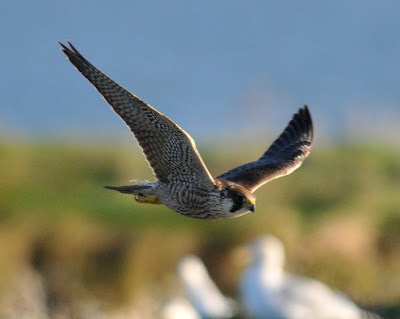Down to Baiter to have another look at those Terns!
Another interesting bird has turned up. This is a bonefide adult bird still with its unmoulted summer primaries, interesting because it is the only one I have seen in this state of plumage out of 10 or so birds that have been around.

Interesing also because according to BWP the primary moult starts as early as mid July and should be completed from end of October to December.
This is where I mention acuflavida again! Apparently the American birds do moult much later.
Dutch birding also makes the comment that any bird seen with unmoulted primaries going into January should be given particular attention. Lets hope it stays around, keeps its primaries and goes a bit balder!
The first visible primaries on this bird could be new although they are markedly different in summer plumaged birds anyway as the outers are not moulted prior to breeding . This can be seen in the pic below of a sum plum bird on Brownsea.
Going back to the above bird, it does look like there is quite a gap from the tip of the last grey primary to the tip of the first dark one, also there are only 3 visible dark primaries. It does look as though this could be a dropped feather particularly if one looks at the sum plum bird below where the gaps are pretty equal and there are four visible dark primaries. Click on the images to enlarge.
It must also be said here that the head pattern does look quite interesting with quite a strong demarcation on the head, although there is flecking on the black area. This shot in flight though does give it that American bald headed look.
The last interesting thing about this bird is that it shows small dusky areas on both outer tail feathers, this can just be seen on the shot below. (click to enlarge). As mentioned earlier this is another feature of adult acuflavida.













Bird+2+juv+with+notching.jpg)
plain+tertials+yellow+legs+prob+bird+1jpg.jpg)
bird+1adult+again+see+tertials+bit+better.jpg)
+bird+2+or+3.jpg)








































